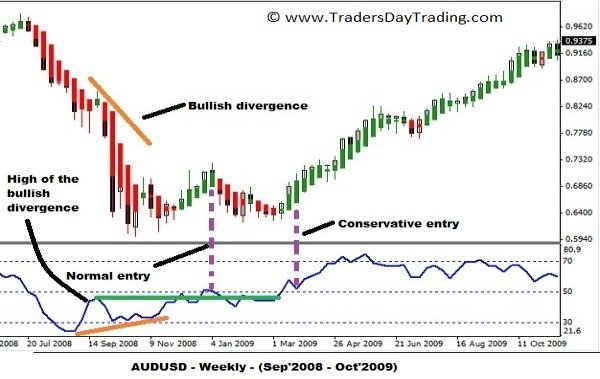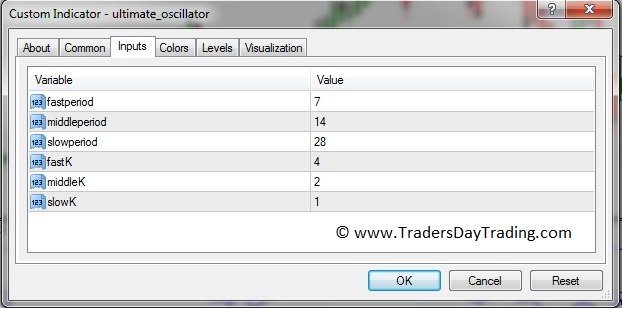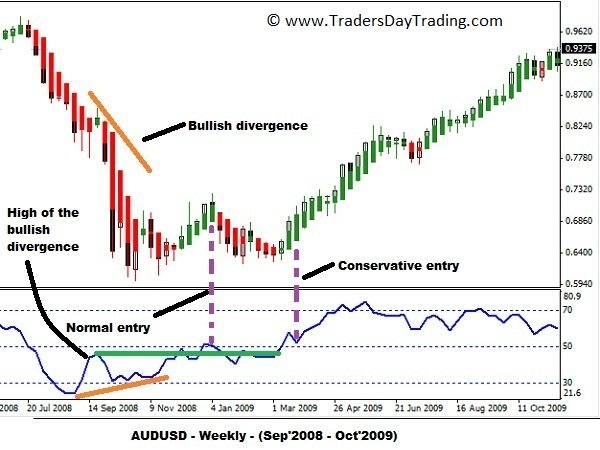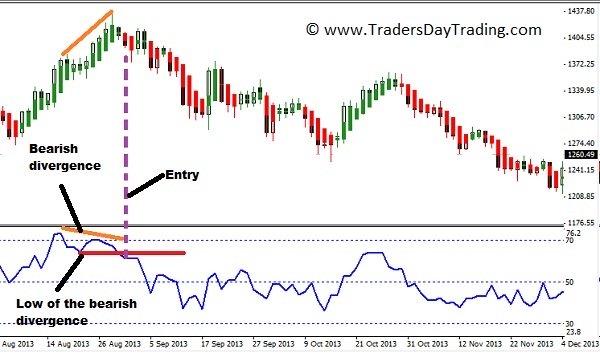Ultimate
Oscillator
The
Ultimate Oscillator Explained
The
Ultimate Oscillator (UO) is a technical indicator used in technical
analysis
charting to help find high probability trend reversal points.
Traders regularly come across false divergence signals while using the
various indicators and oscillators in technical analysis charts and the
Ultimate Oscillator, which reflects the extent of change in buying
pressure in a traded security, was precisely designed to try to
overcome this issue.
What
You Will Learn
- Calculations used in the
construction of the ultimate
oscillator.
- Major
advantage of using an ultimate
oscillator.
- Interpretation
of divergence signals.
- When
to enter a trade.
A
Brief Background
In
1976, Larry Williams, the well-known trader and mathematician,
developed the ultimate oscillator to resolve the issue of fake signals
generated by most of the momentum oscillators.
The indicator was constructed using the weighted average of three
periods instead of one, as in the case of other momentum oscillators.
This results in unwanted volatility being suppressed from the
calculation, thereby avoiding distortion in the representation of the
prevailing trend.

Fig
1:
The Ultimate Oscillator
Construction of the Ultimate
Oscillator
The main objective of the UO indicator
is to reflect the quantum of rise or fall in the buying
pressure that causes the price movement.
Theoretically, the buying pressure
begins to increase or decrease before the actual rise or decline in the
price of an asset. Therefore, a precise measure of the magnitude of a
rise or fall in buying pressure should enable a trader to forecast the
trend in a fairly reliable manner.
To accomplish this, the following
variables are calculated:
- Buying
pressure: Buying pressure (BP) = Close –
Minimum. This is determined by subtracting the close and
the minimum traded price of a security (current lowest price or the
previous close).
- Quantum
of change in buying pressure (gain or loss):
This
is calculated by measuring the buying pressure relative to the True
Range (TR).
So, the foremost step is to calculate
the True Range which is the difference between the current high or
prior close (largest value among the two to be used), and current low
or
previous close (smallest value among the two should be taken).
True Range (TR) = Maximum (High or
previous close) – Minimum (Low or previous close).
Now, in order to determine the
relative buying pressure, n-period sum of BP is divided by the n-period
sum of TR. Not one but three time frames are used to create a
smoothening effect in order to try to remove volatility. Usually, the
default parameters used are 7, 14 and 28 periods.
A =
Average (7-period) = (7-period BP Sum) / (7-period TR Sum)
B = Average (14-period) = (14-period BP Sum) / (14-period TR Sum)
C = Average (28-period) = (28-period BP Sum) / (28-period TR Sum)
Additionally, to give more priority to
the recent price changes, the
weighted average of A, B and C is calculated. The multiplication
factors
(weightage) given to A (shortest average), B (middle average) and C
(longest average) are 4x, 2x and 1x respectively.
Most charting software packages have
provision to change both the input periods, and multiplication factor,
according to the individual preferences of a
trader.

Fig 2: Custom
Oscillator Settings
Finally, the ultimate oscillator value
is calculated by dividing the weighted mean by the sum of the
weightings as follows:
The Ultimate oscillator (UO) = 100 x
[(4 x A) + (2 x B) + 1C] / (4+2+1)
In order to create a binding
oscillator, a multiplication factor of 100 is used in
the formula shown above. This setup also enables a trader to
quickly identify oversold (below 30) and overbought (above 70) levels.
Nature and Interpretation of Trading
Signals
The value of the relative buying
pressure forms the core of the ultimate oscillator. This is because
each and every data used in the construction of the oscillator
represents the buying pressure, relative to the current low, or the
previous close (whichever is lowest).
Thus, the ultimate oscillator value
increases when the buying pressure continues to rise and vice versa. It
should be noted that buying pressure may or may not be in the primary
direction of the price movement of an asset.
It is very common for the price to
continue to rise or fall very rapidly in the final stages of an
established uptrend
or a downtrend. Such a scenario usually triggers a
lot of stop loss orders and also traps a large portion of novice
traders.
However, such a sharp movement in
price is never supported by a rise or fall in the buying pressure. This
is because the smart
market participants wait for such moves to exit
their current positions, or wait for a reversal.
This mismatch is clearly indicated
through the formation of a positive or negative divergence pattern
appearing in the ultimate oscillator indicator.
Ultimate Oscillator Trading Strategy
The ultimate oscillator generates two
kinds of patterns, namely, the (bullish) positive divergence and
(bearish) negative divergence patterns.
Positive Divergence Pattern
A bullish positive divergence is
characterized by the formation of a higher low in the ultimate
oscillator, while the price of the security continues to decline
further producing a lower low before finding support.
A long position should only be taken
once the indicator breaks out, or crosses the
previous high following the bullish divergence.
Another point to remember is that the
origin (low) of the bullish divergence should be below 30 for the
pattern to be reliable.

Fig 3:
Positive Divergence Buy Signal
Negative Divergence Pattern
A bearish negative divergence pattern
is characterized by the formation of a lower high in the indicator
while the price of the price of the security continues to
rise further before finding
resistance, producing a higher high. Once the ultimate
oscillator
declines below the low of the divergence, a short position can be
initiated. In the case of bearish divergence, the origin (high) of the
bearish divergence should be above 70.

Fig 4: UO
Negative Divergence Sell Signal
Advantages
The notable benefit that arises from
the use of the oscillator is the reduction of false signals.
Disadvantages
UO trading signals may prove
ineffective if used as the sole technical indicator for making trading
decisions. Professionals always suggest the use of another indicator
for the validation of the signal generated.
Summary: Ultimate Oscillator
The ultimate oscillator can be an
extremely useful technical indicator which reduces the burden of
filtering out error signals, thereby allowing better trading decisions.
Furthermore, it can be easily combined with other indicators such as
RSI, MACD or Elliott
wave theory to create
a highly effective trading system. Return
to Technical Analysis.
|